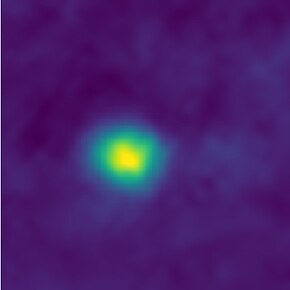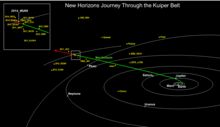
A classical Kuiper belt object, also called a cubewano ( "QB1-o"), is a low-eccentricity Kuiper belt object (KBO) that orbits beyond Neptune and is not controlled by an orbital resonance with Neptune. Cubewanos have orbits with semi-major axes in the 40–50 AU range and, unlike Pluto, do not cross Neptune's orbit. That is, they have low-eccentricity and sometimes low-inclination orbits like the classical planets.
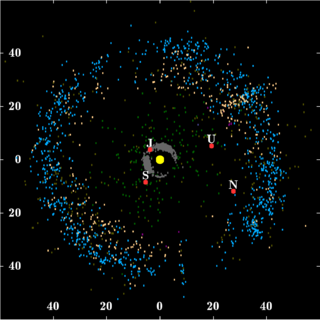
The Kuiper belt is a circumstellar disc in the outer Solar System, extending from the orbit of Neptune at 30 astronomical units (AU) to approximately 50 AU from the Sun. It is similar to the asteroid belt, but is far larger—20 times as wide and 20–200 times as massive. Like the asteroid belt, it consists mainly of small bodies or remnants from when the Solar System formed. While many asteroids are composed primarily of rock and metal, most Kuiper belt objects are composed largely of frozen volatiles, such as methane, ammonia, and water. The Kuiper belt is home to most of the objects that astronomers generally accept as dwarf planets: Orcus, Pluto, Haumea, Quaoar, and Makemake. Some of the Solar System's moons, such as Neptune's Triton and Saturn's Phoebe, may have originated in the region.

A trans-Neptunian object (TNO), also written transneptunian object, is any minor planet in the Solar System that orbits the Sun at a greater average distance than Neptune, which has an orbital semi-major axis of 30.1 astronomical units (au).

New Horizons is an interplanetary space probe launched as a part of NASA's New Frontiers program. Engineered by the Johns Hopkins University Applied Physics Laboratory (APL) and the Southwest Research Institute (SwRI), with a team led by Alan Stern, the spacecraft was launched in 2006 with the primary mission to perform a flyby study of the Pluto system in 2015, and a secondary mission to fly by and study one or more other Kuiper belt objects (KBOs) in the decade to follow, which became a mission to 486958 Arrokoth. It is the fifth space probe to achieve the escape velocity needed to leave the Solar System.

1998 WW31, is a non-resonant trans-Neptunian object and binary system from the Kuiper belt located in the outermost region of the Solar System, approximately 148 kilometers (92 miles) in diameter. It was first observed on 18 November 1998, by American astronomer Marc Buie and Robert Millis at the Kitt Peak National Observatory in Arizona, United States. In December 2000, a minor-planet moon, designated S/2000 (1998 WW31) 1 with a diameter of 123 kilometers (76 miles), was discovered in its orbit. After Charon in 1978, it was the first of nearly 100 satellites since discovered in the outer Solar System.

15810 Arawn, provisional designation 1994 JR1, is a trans-Neptunian object (TNO) from the inner regions of the Kuiper belt, approximately 133 kilometres (83 mi) in diameter. It belongs to the plutinos, the largest class of resonant TNOs. It was named after Arawn, the ruler of the underworld in Welsh mythology, and discovered on 12 May 1994, by astronomers Michael Irwin and Anna Żytkow with the 2.5-metre Isaac Newton Telescope at Roque de los Muchachos Observatory in the Canary Islands, Spain.
(35671) 1998 SN165, prov. designation: 1998 SN165, is a trans-Neptunian object from the Kuiper belt located in the outermost region of the Solar System. It was discovered on 23 September 1998, by American astronomer Arianna Gleason at the Kitt Peak National Observatory near Tucson, Arizona. The cold classical Kuiper belt object is a dwarf planet candidate, as it measures approximately 400 kilometers (250 miles) in diameter. It has a grey-blue color (BB) and a rotation period of 8.8 hours. As of 2021, it has not been named.

Neptune has been directly explored by one space probe, Voyager 2, in 1989. As of September 2023, there are no confirmed future missions to visit the Neptunian system, although a tentative Chinese mission has been planned for launch in 2024. NASA, ESA, and independent academic groups have proposed future scientific missions to visit Neptune. Some mission plans are still active, while others have been abandoned or put on hold.
2011 HM102 is the ninth Neptune trojan discovered. It was first observed on 29 April 2011, during the New Horizons KBO Search (268) using the Magellan II (Clay) Telescope at Las Campanas Observatory in Chile. It has the same orbital period as Neptune and orbits at the L5 Lagrangian point about 60° backwards of Neptune.

New Horizons 2 was a proposed mission to the trans-Neptunian objects by NASA. It was conceived as a planetary flyby mission in 2002, based on the New Horizons spacecraft, which was in development at the time. In March 2005, the proposal was not selected for further development because of a shortage of plutonium-238 needed for the radioisotope thermoelectric generator (RTG). The New Horizons 2 study was funded out of the New Frontiers program, and was delivered to the U.S. Congress in June 2005.

486958 Arrokoth (provisional designation 2014 MU69; formerly nicknamed Ultima Thule) is a trans-Neptunian object located in the Kuiper belt. Arrokoth became the farthest and most primitive object in the Solar System visited by a spacecraft when the NASA space probe New Horizons conducted a flyby on 1 January 2019. Arrokoth is a contact binary 36 km (22 mi) long, composed of two planetesimals 21 and 15 km (13 and 9 mi) across, that are joined along their major axes. With an orbital period of about 298 years and a low orbital inclination and eccentricity, Arrokoth is classified as a cold classical Kuiper belt object.
2011 KW48, temporarily designated VNH0004, is a trans-Neptunian object from the inner classical part of the Kuiper belt, located in the outermost region of the Solar System. It measures approximately 77 kilometers (48 mi) in diameter.
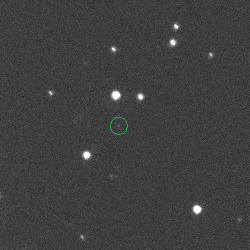
2014 PN70 (internally designated g12000JZ, g1 and PT3) is a trans-Neptunian object from the cold classical Kuiper belt located in the outermost region of the Solar System. It measures approximately 40 kilometers (25 miles) in diameter. The object was first observed by the New Horizons Search Team using the Hubble Space Telescope on 6 August 2014, and was a proposed flyby target for the New Horizons probe until 2015, when the alternative target 486958 Arrokoth was selected.
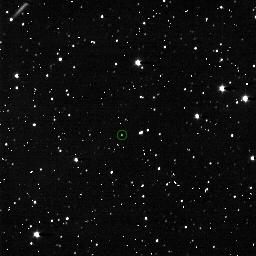
2014 OS393, unofficially designated e31007AI, e3 and PT2, is a binary trans-Neptunian object in the classical Kuiper belt, the outermost region of the Solar System. It was first observed by the New Horizons KBO Search using the Hubble Space Telescope on 30 July 2014. Until 2015, when the object 486958 Arrokoth was selected, it was a potential flyby target for the New Horizons probe. Estimated to be approximately 42 kilometres (26 mi) in diameter, the object has a poorly determined orbit as it had been observed for only a few months.

2014 MT69 (internally designated 0720090F in the context of the Hubble Space Telescope, and 7 in the context of the New Horizons mission) is a cold classical Kuiper belt object (KBO) and was formerly a potential flyby target for the New Horizons probe. The object measures approximately 20–90 kilometers (12–56 miles) in diameter.

2017 OF69 is a resonant trans-Neptunian object from the Kuiper belt, located in the outermost region of the Solar System in the Kuiper belt's plutino population and measures approximately 533 kilometers (330 miles) in diameter. It was first observed on 26 July 2017, by American astronomers David Tholen, Scott Sheppard, and Chad Trujillo at Mauna Kea Observatories in Hawaii, but not announced until 31 May 2018 due to observations made in April and May 2018 refining its orbit significantly.
(523702) 2014 HW199, provisional designation 2014 HW199, is a trans-Neptunian object from the classical Kuiper belt, located in the outermost region of the Solar System. It was discovered on 30 January 2011, by astronomers with the Pan-STARRS survey at Haleakala Observatory, Hawaii, United States. The classical Kuiper belt object is also a dwarf planet candidate, as it measures approximately 290 kilometers (180 miles) in diameter.

(516977) 2012 HZ84, provisional designation 2012 HZ84, is a small trans-Neptunian object from the Kuiper belt located in the outermost region of the Solar System, approximately 74 kilometers (46 miles) in diameter. It was discovered on 17 April 2012, by a team of astronomers using one of the Magellan Telescopes in Chile during the New Horizons KBO Search in order to find a potential flyby target for the New Horizons spacecraft. In December 2017, this classical Kuiper belt object was imaged by the spacecraft from afar at a record distance from Earth.
2011 JY31 is a binary trans-Neptunian object from the Kuiper belt, located in the outermost region of the Solar System. It was discovered on 4 May 2011, by a team of astronomers using one of the Magellan Telescopes in Chile during the New Horizons KBO Search for a potential flyby target for the New Horizons spacecraft. Distant observations by New Horizons from September 2018 revealed its binary nature, showing two 50 km (31 mi)-wide components in a tight, mutual orbit 200 km (120 mi) apart. The discovery adds support to streaming instability as the dominant mechanism in the formation of tight and contact binary planetesimals such as 486958 Arrokoth, which appear to be prevalent in the cold classical Kuiper belt population.

Timeline for the New Horizons interplanetary space probe lists the significant events of the launch, transition phases as well as subsequent significant operational mission events; by date and brief description.
